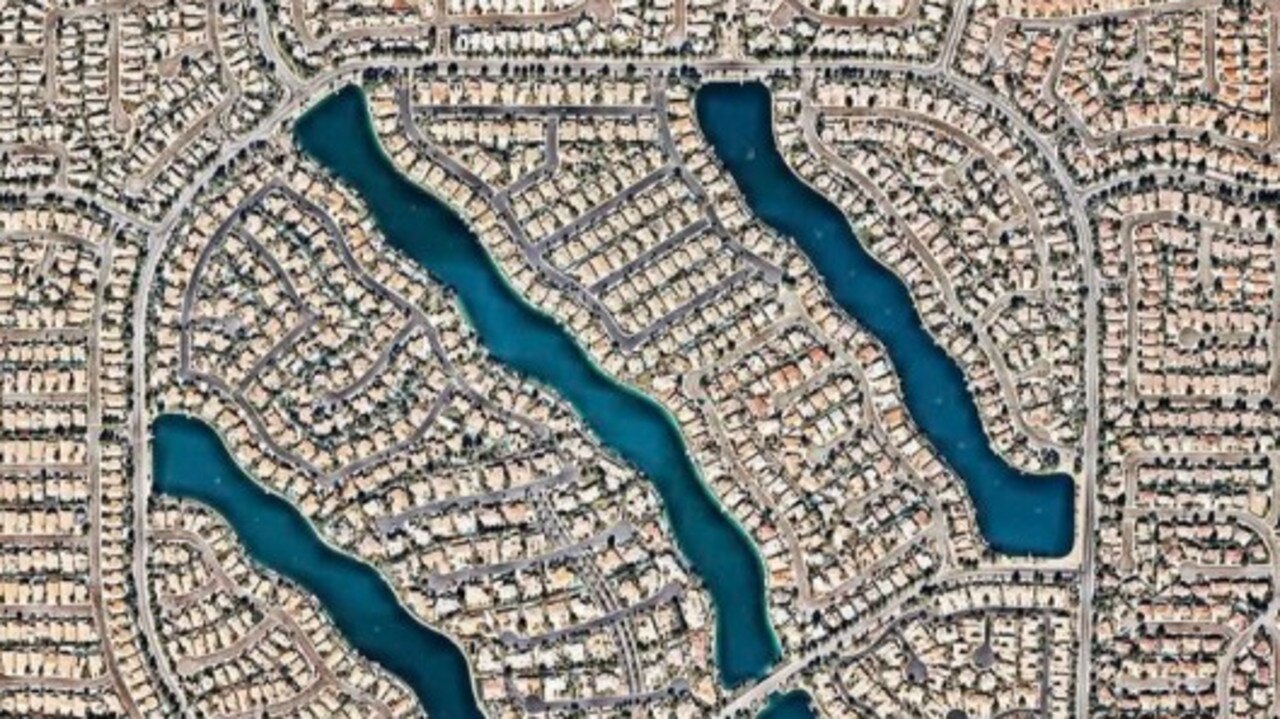‘We’re doomed’: Expert loses it over jaw-dropping image
An Australian academic has urged the federal government to have “honest conversations” about how future generations will be forced to live.
An Australian academic has urged the federal government to have “honest conversations” about how future generations will be forced to live after sharing jaw-dropping images of built up Australian and US cities with very little green space.
Philip Oldfield, Head of Built Environment at UNSW said Australia had the potential
to look like Nevada in the US with a plethora of low-density housing surrounded by swathes of roads, which could be unliveable without airconditioning in the future.
Sharing an image of Desert Shores, Nevada, which has 3,300 homes across 276 hectares (that’s a density of 12 units per hectare), he quipped: “We’re doomed aren’t we?”


“What we know is that this type of living is very carbon intensive,” he said.
“But it is also bad for the people who live there. There is a very little green space, there is very little amenity, how easy is it if you live in an environment like that to bump into a neighbour, walk to the shops, or keep cool during a heatwave?”
Some suburbs of Nevada currently have 12 houses per hectare, compared to suburban development in Australia which tends to be closer to 15-20 houses per hectare.
We’re doomed aren’t we?
— Philip Oldfield (@SustainableTall) February 6, 2023
Desert Shores, Nevada. 3,300 homes across 276 hectares (that’s a density of 12 units per hectare) https://t.co/xCCUJrdPZtpic.twitter.com/NWyOAnIBlU
While he acknowledged Australia needed to build more homes due to population growth and housing affordability he said that needs to be done in a more thoughtful way rather than being driven by pure economics.
“When you build a house it lasts 50 to 100 years when you build a community it last 100-200 years, the development we are making at a moment will be standing in our great grandchildren’s time. We need to have an honest and authentic conversation about how we want our future generations to live in a world which will be hotter, health will be more challenging, we need to be investing in this today.”
To allow for such a high density (740 units/hectare) there is a high level of amenity at ground, and at height.
— Philip Oldfield (@SustainableTall) February 6, 2023
Here for instance is the children’s play area on level 26.
There’s also a gym for the elderly, a community centre and an 800m running track at level 26. pic.twitter.com/TbZ0BsTBiq
He used western Sydney as an example: “Instead of building out in Sydney why not build high speed rail connecting Newcastle and Wollongong, then we can build up Newcastle and Wollongong which is closer to the water and easy to ventilate?”
Associate Professor Oldfield cites Singapore and Barcelona as examples of cities that are getting it right.
“Singapore has aggressive building regulations, that if you build a certain amount of green space.”
An increasingly urbanised world
Researchers at UNSW say that more than half the world’s population lives in urban areas and it is estimated by 2050, that number will increase to 68 per cent.
However, with urbanisation comes challenges such as meeting the needs of growing urban populations and addressing the demand for housing, transportation, energy systems, and infrastructure while ensuring the benefits of urbanisation are inclusive, equitable and sustainable.
“Cities are one of humanity’s best inventions, fueling innovation, prosperity and diversity. But many are no longer fit for purpose. Increasingly they exacerbate climate change, ill health, and inequalities. They lack agility and resilience. We are optimistic that it doesn’t have to be that way,” says Professor Claire Annesley, Dean of UNSW Arts, Design & Architecture.
More Coverage
To address these challenges, UNSW Sydney has launched the UNSW Cities Institute, an independent institute working in partnership with government and industry to reinvent cities for sustainable, healthy, prosperous and socially just urban futures.
“Our approach is to lead and accelerate positive change by building cross-disciplinary teams together with government, industry and communities, working together to develop innovative solutions to the problems facing our cities and our planet,” said Prof Claire.
“This means getting climate change experts to work with population health, housing and transport experts to design and deliver a more resilient urban future.”






